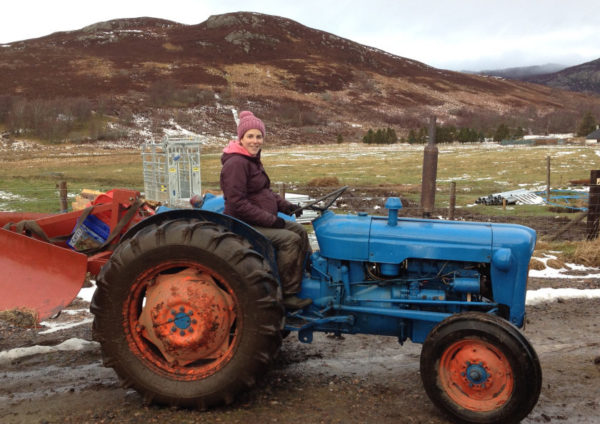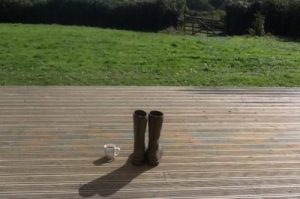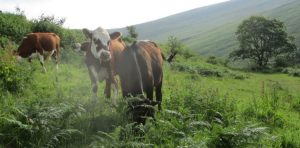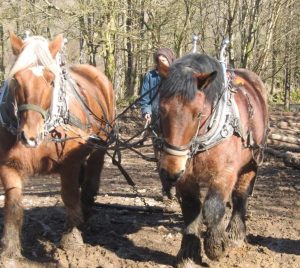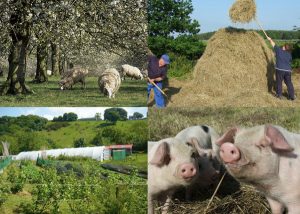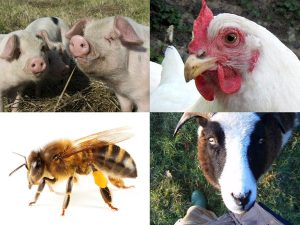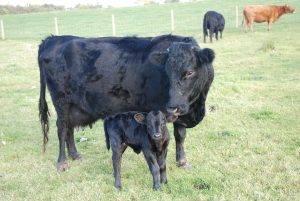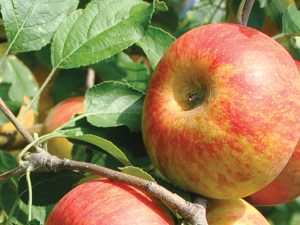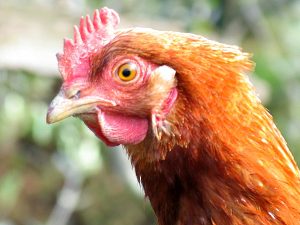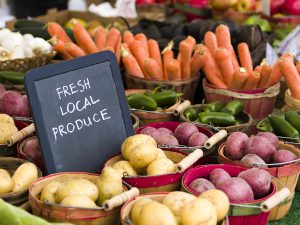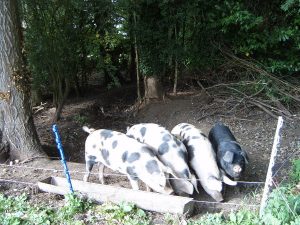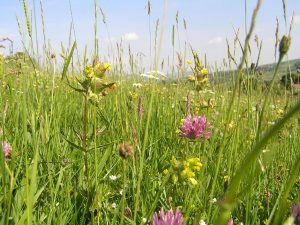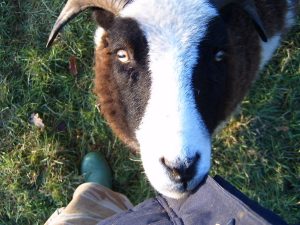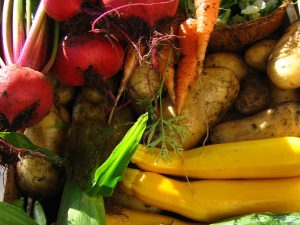Lesley Anderson learns about the ups and downs of life for crofters Beth and Tim Rose at Birchwood Croft in the Scottish Highlands.
At this year’s Scottish Smallholder festival I saw an inspiring talk by Beth and Tim Rose about taking on a fallow croft and bringing it back into production. Afterwards I got in touch with Beth to find out more about their life on the croft.
Birchwood Croft, on the south side of Loch Ness, backing onto the Monalith Mountains, is 35 acres of grass for hay making, pasture, rough ground and woodland, both old and newly planted. On it, Tim and Beth raise Shetland cattle, sheep, poultry and pigs, as well as growing fruit and vegetables. They breed the cattle but currently buy in weaners and lambs. The main business is selling high quality meat, with the most reliable income coming from the beef and pork.

Birchwood Croft
Beth knew when she married Tim that he wanted a croft or a smallholding. Tim had some experience of seasonal farm work, but Beth’s only experience of farm life was a holiday on a dairy farm as a 15-year-old. It took 6 years in total to find their croft. They looked at many pieces of land, but often found themselves bidding against equestrian buyers who seemed to have far more disposable income to spend, and Beth needed to find a croft within driving distance of a hospital as she works as an NHS theatre nurse. They moved onto Birchwood Croft in 2012.
Their perseverance and determination in building up their croft is impressive. When they bought the croft there were no boundary fences, no outbuildings, no water supply and no house. They spent the first 14 months living in a caravan. Now Birchwood is a full working croft with fences, sheds (never enough, says Tim!), machinery, and (thankfully!) a house. There is also an orchard, soft fruit area, vegetable garden, polytunnel and 5,000 new trees.
Beth says a lot of research goes on before they embark on a project—lots of reading and talking to people with experience:
“We don’t tend to dive head first and try to think through the practicality of things. You can’t think of every situation but just probing people with experience is useful to then think: is it manageable?”
She has also found the Scottish Crofting Federation great for practical one day courses such as sheep shearing, grass management, making tax digital and reed control. As a nurse, Beth has been trained to use ‘reflective practice’ which she finds just as useful for managing the croft: “a great wee tool for looking at what we have done and how we can improve. “

Shetland cow and calf.
Life and working the croft
Tim works offshore for up to 5 weeks at a time, during which Beth manages the croft solo. Beth, who is currently on a career break, says that if ‘the antics’ of the croft are going to kick off, it will happen when Tim is away. In one blog she reports in a single day the escape of 2 steers and 4 heifers, then one ram, then another steer (who thought the bucket used to retrieve the ram was for him), then one young calf and, finally, one blackface sheep. All on a day when lambing had just started!
As if running a croft single-handed wasn’t challenging enough Beth does it with a toddler in tow (the mini-crofter as she calls him in her blog) and now a ‘micro-crofter’ on board (due any day at the time of writing). This sounds exhausting to me, and it is, but Beth seems to relish it most of the time:
Don’t tell anyone until after you have sheared the sheep and baled the hay field. People like to stop you having fun.
Even when she is heavily pregnant, the work still needs to be done:
Nesting’ is for the chickens. During the latter stages, when you are not in your ‘paid work’, you are able to complete jobs that have been on your to-do list since the house was built 3 years ago.

More than the ‘all terrain’ buggy was designed to cope with!
Beth also takes a pragmatic approach to the avoidance of heavy lifting, and what should and should not be mentioned to her midwives.
Levering and lifting are two different words. Big stones are useful, just not where a gate post needs to be fixed.
I must say I share Beth’s frustration with the lack of availability of practical outdoor maternity clothing, but I don’t think I could work a croft while 9 months pregnant. Beth, I take my hat off to you!
Both Beth and Tim worked full-time as well as running the croft in the initial years. Beth says that this allowed them to focus on supplying quality meat and building up a reputation, rather than on the need to generate an income. They aim for the income from the meat to cover the cost of raising the animals and pay for their labour. In the long-term, Beth envisions that at least one of them will need to keep working in another job. She points out that, throughout history, crofting was always just one income stream, and crofters almost always had additional sources of income. She says they have looked at ways of improving their income from the croft, but a certain amount of flexibility and creativity are needed!

The mini crofter
Plans for the future
Eventually Beth hopes that the croft will be able to provide one full income, but to do that they need to find a niche market they can take on. They have looked into a micro whisky distillery but they need funding for this and, especially with Brexit looming, obtaining funding can be tricky for a small business.
Beth and Tim did have laying chickens for eggs, but Beth has found the smell of poultry impossible to deal with while pregnant and they got rid of them in the autumn. They hope to start up that side of the business again in spring. They also tried lambing in 2017, but concluded it was too much to take on in the next few years: Beth had already found managing everything on her own tricky with a full-time job, but things became much more complicated with the arrival of the mini-crofter. She found herself managing a lambing flock while looking after a 3 month old baby, who was waking to feed every 2 hours at night! So for now they buy in lambs to fatten and plan to try again once the kids are at school.
When asked about their other plans for the future Beth is focused simply on improving the croft, whether that be in terms of efficiency, planting trees or improving pasture. They are learning all the time; after doing a course in reed management, Beth realised a piece of rough land had more potential than she had previously realised. They have put in drainage and are hoping to get it limed ploughed and reseeded to provide their livestock with good quality grazing.

Improving drainage on the rough land
The challenges
Beth says the most challenging thing about being a crofter is having to work on your own and deal with whatever nature throws at you. You can get snowed it, the water supply gets frozen, there are power cuts…
You can’t just leave it as animals need water supply and so on, so it means having to face things you might otherwise just ‘sit out’ if you have no dependants. With livestock, you get deadstock.
She also finds it hard dealing with animals in pain and needing medical attention. Unlike a patient she might see when working as a nurse, an animal can’t tell you what’s wrong.
One of our 5 month old calves got a prolapsed rectum. The vet and I had to battle trying to get it back in while out in the field, horizontal rain, and by head torch. It was emotionally hard when it was decided she had to be euthanized.
She says sending the animals to the abattoir is different:
Sending for slaughter, the animal has had a good life and will have a quick and stress free ending. Being put down due to a veterinary issue is hard for a lot of livestock keepers.

Delivering hay by wheel barrow when the tractor breaks down
Starting out as a crofter
When asked what advice she would give anyone starting out Beth says to always seek to learn; to improve your knowledge and practical skills. Don’t be afraid to ask for advice; no one will look down on you for asking questions. Go on courses; the Scottish Crofting Federation (SCF) is great for one day practical courses, the Soil Association and the Scottish Agricultural College also offer courses. Network and join groups like Women in Agriculture and SCF.
Regardless of how long you have been doing it, always think that you can gain better skills, knowledge to ensure you are doing the very best.
The help of friends and neighbours has been invaluable, especially when Beth is running the croft on her own while looking after a toddler and a stomach bug has struck.
Our friends who volunteer themselves and are willing to help, Tim and I are much indebted to – without them, the circus (sorry, croft), wouldn’t function. The ‘community’ is still alive and well and willing to help.
Beth also feels crofters need to realise the wealth of experience and practical help farmers have to offer. Her farming neighbours have been generous with their time and advice, helping with sick calves, orphan calves and pallets of cattle feed delivered to the wrong location miles away!
Over the past few months, two local farmers have come and helped us out in two different circumstances. Both never indicated how much of their time was taken away from their own jobs, both offering their time and knowledge which was great for getting a job done and also for finding out little, gleaned gems of information.

Jacob and Shetland sheep.
Beth also has a number of other tips for making things easier on yourself:
- Make livestock handling as efficient as possible from the start – think through what you need to do with them and what equipment you have and what you need
- Know when to contract out a job – while Tim built their first shed, they got a contractor to put up their byre and the boundary fences
- Use appropriate machinery and equipment – Beth and Tim have learned the hard way it is better to spend money on kit which is up to the job and won’t cost twice in much in labour and money when it breaks down
- Don’t be afraid to give things up – as Beth and Tim found with lambing, some projects won’t be a good fit, you can always try again when thing change
- Be prepared for children to slow you down a lot!
Perhaps most importantly Beth says:
Don’t think you have to be superhuman- another smallholder or crofter may look like they have it mastered but rarely will they if you speak to them.

Wilma, Julia and Marcia. Goucester old spot x saddleback pigs were used to dig land inaccessible by tractor while they fattened up.
The rewards of crofting
The rewards for Beth come from the simple pay-offs of her hard work:
You get the benefits for the things you have invested time into. Enjoying the smell of hay that you have made.
When asked why crofting is important Beth says crofting utilises the land that would otherwise be taken over by thistles and reeds where little would be able thrive. She says the crop improves the biodiversity of the land as well as making it productive, for example, allowing trees to grow by managing the deer.
We can use the land not just for our benefit but for the wildlife around us. It makes us appreciate what we are given, the seasons.

Making hay
Do check out Beth’s blog, an often humorous look at the challenges of crofting in general, and crofting while pregnant and with mini-crofter in tow in particular. It is interspersed with the occasional political commentary on issues relevant to farmers and crofters. You can also buy their high quality, ethically reared meat.


Lesley Anderson holds the diploma in Applied Permaculture Design and is on the Permaculture Scotland working group. She studied animal behaviour at university and has an interest in how animals can be ethically integrated into our sustainable systems. For several years she worked with horses and volunteered on organic farms through WWOOF. Now Lesley lives in Fife with her husband, son and ducks.

